Health Culture and Society: Social Determinants of Health in Australia
VerifiedAdded on 2022/08/24
|5
|1193
|19
Report
AI Summary
This report delves into the pervasive issue of cardiovascular disease (CVD) within Australian society, highlighting its significant impact on public health and the healthcare system. It identifies CVD as a leading cause of mortality and morbidity, placing a substantial burden on healthcare resources. The report explores various risk factors contributing to CVD, including lifestyle choices and socioeconomic disparities. Furthermore, it examines the social determinants of health, such as social exclusion and the built environment, and their influence on CVD prevalence, particularly among Indigenous Australians. The analysis underscores the need for targeted interventions and policy changes to address these social determinants and mitigate the burden of CVD, emphasizing the importance of comprehensive strategies to promote health equity and improve overall population health outcomes. The report stresses the need for Australian health organizations to address these social determinants to improve public health.
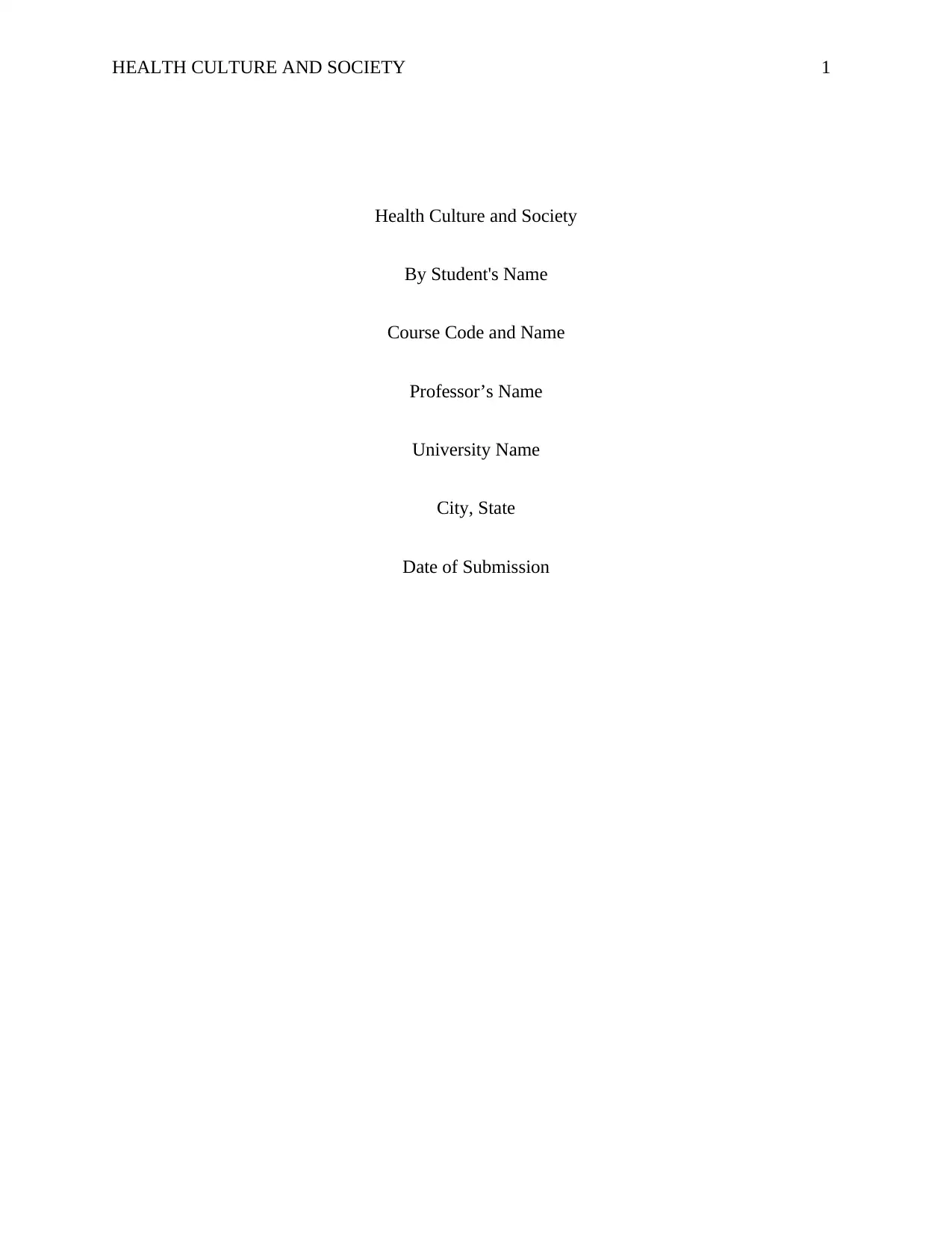
HEALTH CULTURE AND SOCIETY 1
Health Culture and Society
By Student's Name
Course Code and Name
Professor’s Name
University Name
City, State
Date of Submission
Health Culture and Society
By Student's Name
Course Code and Name
Professor’s Name
University Name
City, State
Date of Submission
Paraphrase This Document
Need a fresh take? Get an instant paraphrase of this document with our AI Paraphraser
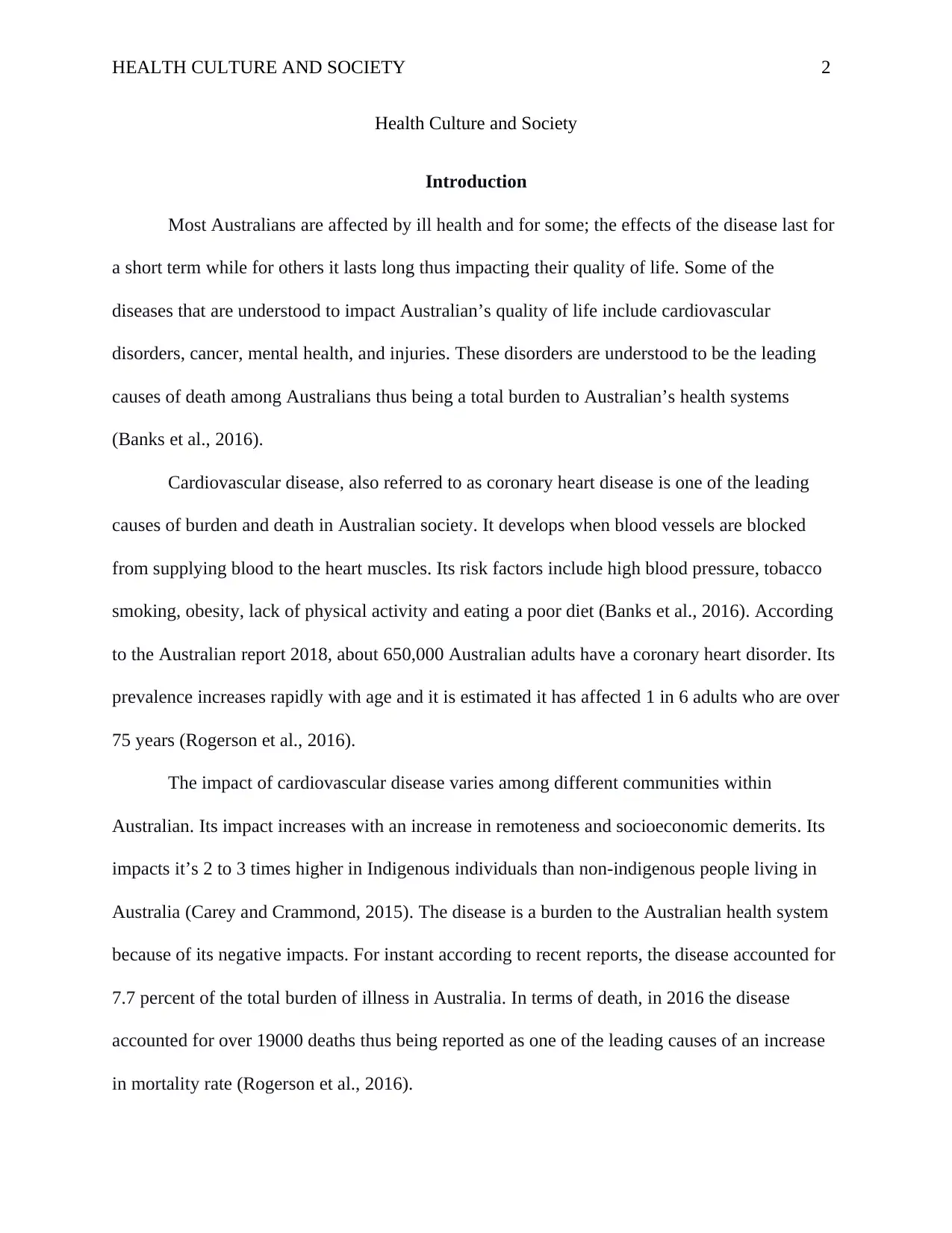
HEALTH CULTURE AND SOCIETY 2
Health Culture and Society
Introduction
Most Australians are affected by ill health and for some; the effects of the disease last for
a short term while for others it lasts long thus impacting their quality of life. Some of the
diseases that are understood to impact Australian’s quality of life include cardiovascular
disorders, cancer, mental health, and injuries. These disorders are understood to be the leading
causes of death among Australians thus being a total burden to Australian’s health systems
(Banks et al., 2016).
Cardiovascular disease, also referred to as coronary heart disease is one of the leading
causes of burden and death in Australian society. It develops when blood vessels are blocked
from supplying blood to the heart muscles. Its risk factors include high blood pressure, tobacco
smoking, obesity, lack of physical activity and eating a poor diet (Banks et al., 2016). According
to the Australian report 2018, about 650,000 Australian adults have a coronary heart disorder. Its
prevalence increases rapidly with age and it is estimated it has affected 1 in 6 adults who are over
75 years (Rogerson et al., 2016).
The impact of cardiovascular disease varies among different communities within
Australian. Its impact increases with an increase in remoteness and socioeconomic demerits. Its
impacts it’s 2 to 3 times higher in Indigenous individuals than non-indigenous people living in
Australia (Carey and Crammond, 2015). The disease is a burden to the Australian health system
because of its negative impacts. For instant according to recent reports, the disease accounted for
7.7 percent of the total burden of illness in Australia. In terms of death, in 2016 the disease
accounted for over 19000 deaths thus being reported as one of the leading causes of an increase
in mortality rate (Rogerson et al., 2016).
Health Culture and Society
Introduction
Most Australians are affected by ill health and for some; the effects of the disease last for
a short term while for others it lasts long thus impacting their quality of life. Some of the
diseases that are understood to impact Australian’s quality of life include cardiovascular
disorders, cancer, mental health, and injuries. These disorders are understood to be the leading
causes of death among Australians thus being a total burden to Australian’s health systems
(Banks et al., 2016).
Cardiovascular disease, also referred to as coronary heart disease is one of the leading
causes of burden and death in Australian society. It develops when blood vessels are blocked
from supplying blood to the heart muscles. Its risk factors include high blood pressure, tobacco
smoking, obesity, lack of physical activity and eating a poor diet (Banks et al., 2016). According
to the Australian report 2018, about 650,000 Australian adults have a coronary heart disorder. Its
prevalence increases rapidly with age and it is estimated it has affected 1 in 6 adults who are over
75 years (Rogerson et al., 2016).
The impact of cardiovascular disease varies among different communities within
Australian. Its impact increases with an increase in remoteness and socioeconomic demerits. Its
impacts it’s 2 to 3 times higher in Indigenous individuals than non-indigenous people living in
Australia (Carey and Crammond, 2015). The disease is a burden to the Australian health system
because of its negative impacts. For instant according to recent reports, the disease accounted for
7.7 percent of the total burden of illness in Australia. In terms of death, in 2016 the disease
accounted for over 19000 deaths thus being reported as one of the leading causes of an increase
in mortality rate (Rogerson et al., 2016).
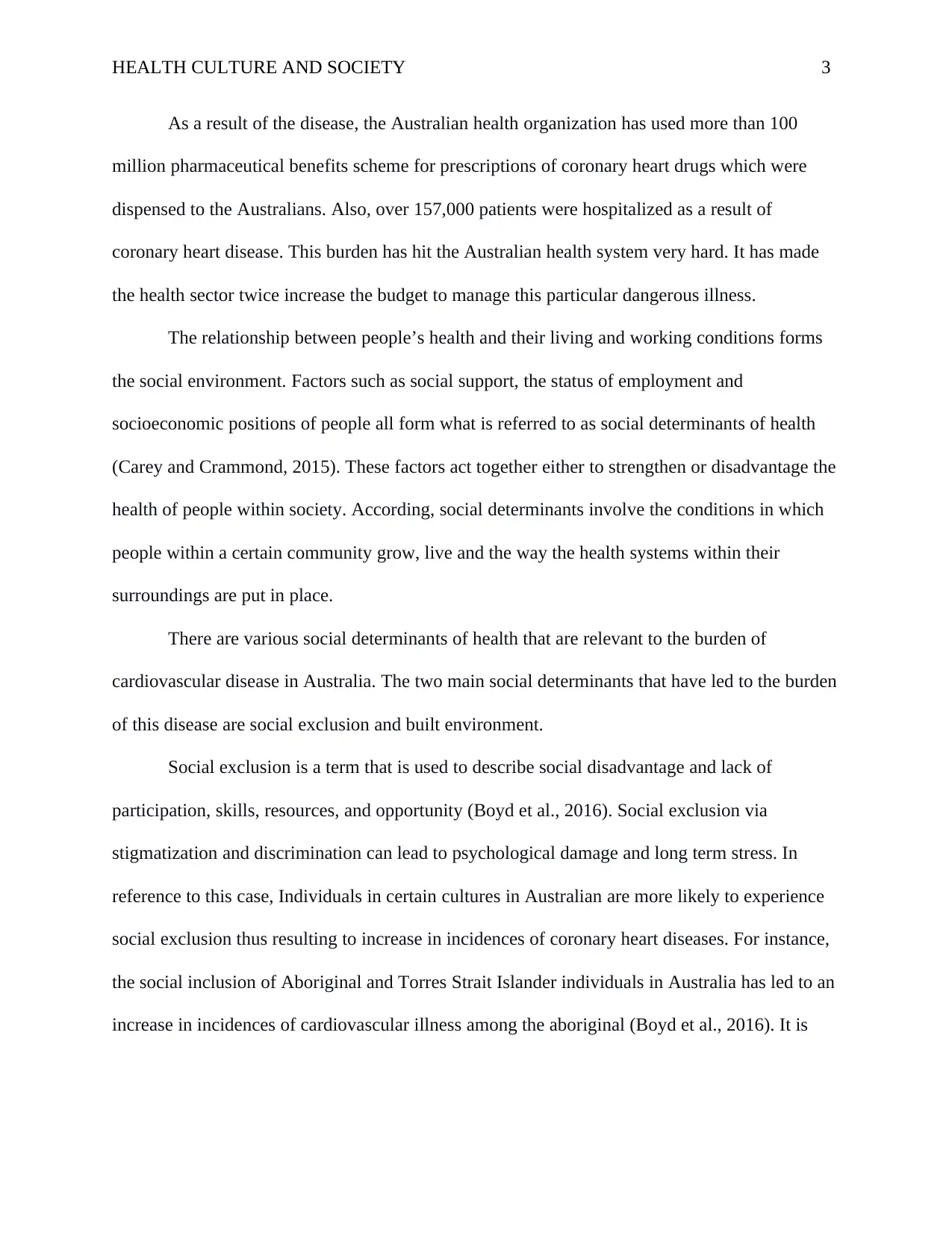
HEALTH CULTURE AND SOCIETY 3
As a result of the disease, the Australian health organization has used more than 100
million pharmaceutical benefits scheme for prescriptions of coronary heart drugs which were
dispensed to the Australians. Also, over 157,000 patients were hospitalized as a result of
coronary heart disease. This burden has hit the Australian health system very hard. It has made
the health sector twice increase the budget to manage this particular dangerous illness.
The relationship between people’s health and their living and working conditions forms
the social environment. Factors such as social support, the status of employment and
socioeconomic positions of people all form what is referred to as social determinants of health
(Carey and Crammond, 2015). These factors act together either to strengthen or disadvantage the
health of people within society. According, social determinants involve the conditions in which
people within a certain community grow, live and the way the health systems within their
surroundings are put in place.
There are various social determinants of health that are relevant to the burden of
cardiovascular disease in Australia. The two main social determinants that have led to the burden
of this disease are social exclusion and built environment.
Social exclusion is a term that is used to describe social disadvantage and lack of
participation, skills, resources, and opportunity (Boyd et al., 2016). Social exclusion via
stigmatization and discrimination can lead to psychological damage and long term stress. In
reference to this case, Individuals in certain cultures in Australian are more likely to experience
social exclusion thus resulting to increase in incidences of coronary heart diseases. For instance,
the social inclusion of Aboriginal and Torres Strait Islander individuals in Australia has led to an
increase in incidences of cardiovascular illness among the aboriginal (Boyd et al., 2016). It is
As a result of the disease, the Australian health organization has used more than 100
million pharmaceutical benefits scheme for prescriptions of coronary heart drugs which were
dispensed to the Australians. Also, over 157,000 patients were hospitalized as a result of
coronary heart disease. This burden has hit the Australian health system very hard. It has made
the health sector twice increase the budget to manage this particular dangerous illness.
The relationship between people’s health and their living and working conditions forms
the social environment. Factors such as social support, the status of employment and
socioeconomic positions of people all form what is referred to as social determinants of health
(Carey and Crammond, 2015). These factors act together either to strengthen or disadvantage the
health of people within society. According, social determinants involve the conditions in which
people within a certain community grow, live and the way the health systems within their
surroundings are put in place.
There are various social determinants of health that are relevant to the burden of
cardiovascular disease in Australia. The two main social determinants that have led to the burden
of this disease are social exclusion and built environment.
Social exclusion is a term that is used to describe social disadvantage and lack of
participation, skills, resources, and opportunity (Boyd et al., 2016). Social exclusion via
stigmatization and discrimination can lead to psychological damage and long term stress. In
reference to this case, Individuals in certain cultures in Australian are more likely to experience
social exclusion thus resulting to increase in incidences of coronary heart diseases. For instance,
the social inclusion of Aboriginal and Torres Strait Islander individuals in Australia has led to an
increase in incidences of cardiovascular illness among the aboriginal (Boyd et al., 2016). It is
⊘ This is a preview!⊘
Do you want full access?
Subscribe today to unlock all pages.

Trusted by 1+ million students worldwide
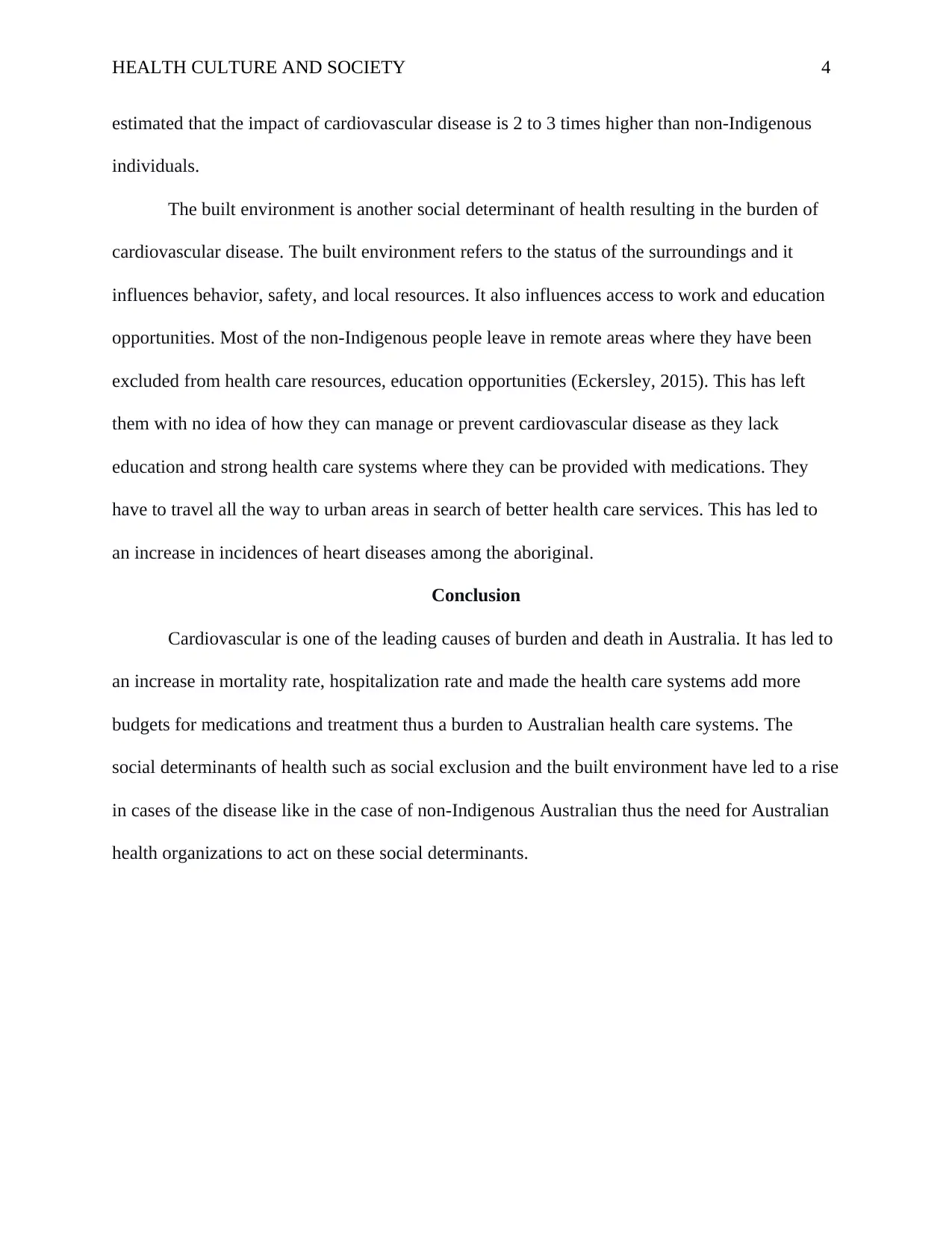
HEALTH CULTURE AND SOCIETY 4
estimated that the impact of cardiovascular disease is 2 to 3 times higher than non-Indigenous
individuals.
The built environment is another social determinant of health resulting in the burden of
cardiovascular disease. The built environment refers to the status of the surroundings and it
influences behavior, safety, and local resources. It also influences access to work and education
opportunities. Most of the non-Indigenous people leave in remote areas where they have been
excluded from health care resources, education opportunities (Eckersley, 2015). This has left
them with no idea of how they can manage or prevent cardiovascular disease as they lack
education and strong health care systems where they can be provided with medications. They
have to travel all the way to urban areas in search of better health care services. This has led to
an increase in incidences of heart diseases among the aboriginal.
Conclusion
Cardiovascular is one of the leading causes of burden and death in Australia. It has led to
an increase in mortality rate, hospitalization rate and made the health care systems add more
budgets for medications and treatment thus a burden to Australian health care systems. The
social determinants of health such as social exclusion and the built environment have led to a rise
in cases of the disease like in the case of non-Indigenous Australian thus the need for Australian
health organizations to act on these social determinants.
estimated that the impact of cardiovascular disease is 2 to 3 times higher than non-Indigenous
individuals.
The built environment is another social determinant of health resulting in the burden of
cardiovascular disease. The built environment refers to the status of the surroundings and it
influences behavior, safety, and local resources. It also influences access to work and education
opportunities. Most of the non-Indigenous people leave in remote areas where they have been
excluded from health care resources, education opportunities (Eckersley, 2015). This has left
them with no idea of how they can manage or prevent cardiovascular disease as they lack
education and strong health care systems where they can be provided with medications. They
have to travel all the way to urban areas in search of better health care services. This has led to
an increase in incidences of heart diseases among the aboriginal.
Conclusion
Cardiovascular is one of the leading causes of burden and death in Australia. It has led to
an increase in mortality rate, hospitalization rate and made the health care systems add more
budgets for medications and treatment thus a burden to Australian health care systems. The
social determinants of health such as social exclusion and the built environment have led to a rise
in cases of the disease like in the case of non-Indigenous Australian thus the need for Australian
health organizations to act on these social determinants.
Paraphrase This Document
Need a fresh take? Get an instant paraphrase of this document with our AI Paraphraser
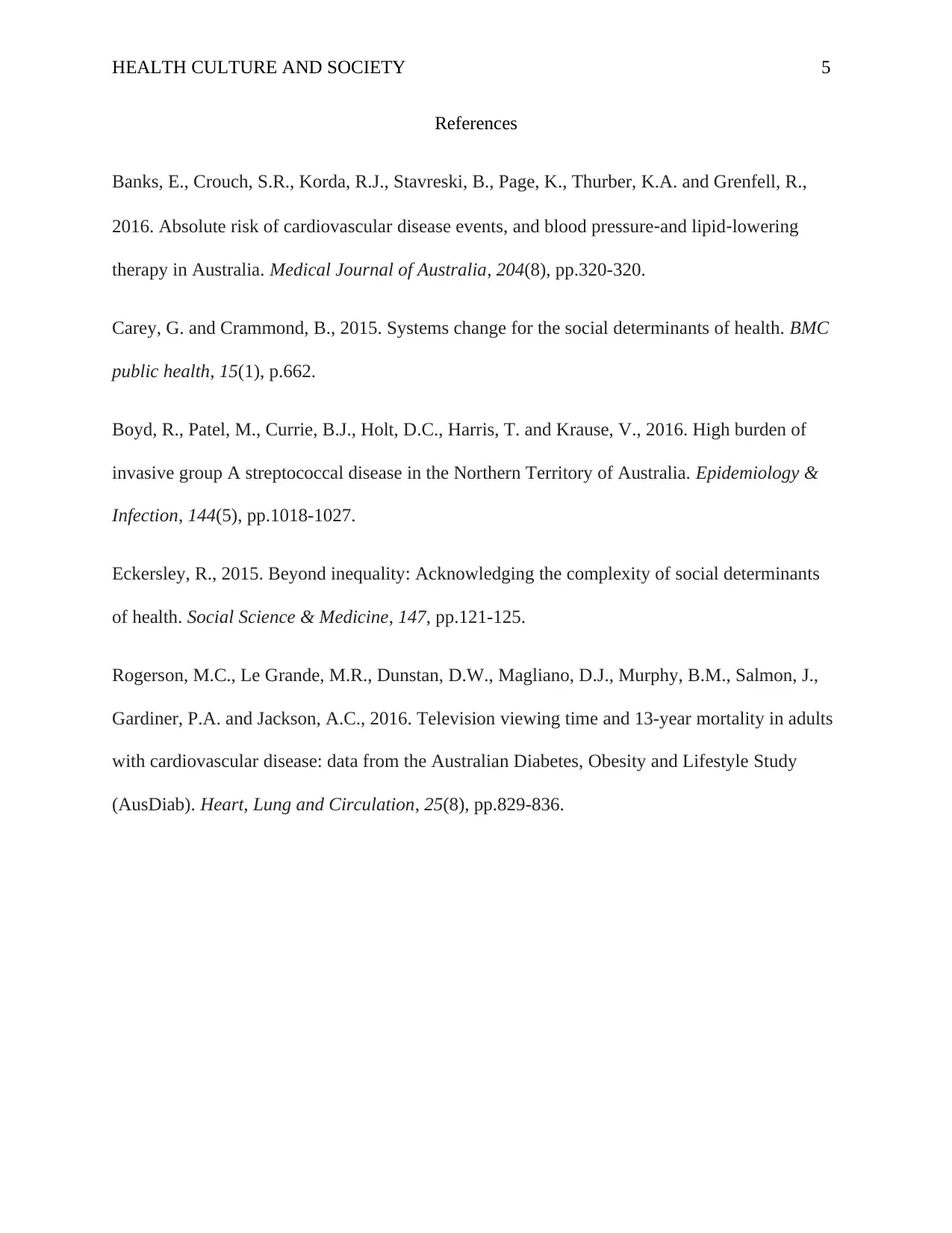
HEALTH CULTURE AND SOCIETY 5
References
Banks, E., Crouch, S.R., Korda, R.J., Stavreski, B., Page, K., Thurber, K.A. and Grenfell, R.,
2016. Absolute risk of cardiovascular disease events, and blood pressure‐and lipid‐lowering
therapy in Australia. Medical Journal of Australia, 204(8), pp.320-320.
Carey, G. and Crammond, B., 2015. Systems change for the social determinants of health. BMC
public health, 15(1), p.662.
Boyd, R., Patel, M., Currie, B.J., Holt, D.C., Harris, T. and Krause, V., 2016. High burden of
invasive group A streptococcal disease in the Northern Territory of Australia. Epidemiology &
Infection, 144(5), pp.1018-1027.
Eckersley, R., 2015. Beyond inequality: Acknowledging the complexity of social determinants
of health. Social Science & Medicine, 147, pp.121-125.
Rogerson, M.C., Le Grande, M.R., Dunstan, D.W., Magliano, D.J., Murphy, B.M., Salmon, J.,
Gardiner, P.A. and Jackson, A.C., 2016. Television viewing time and 13-year mortality in adults
with cardiovascular disease: data from the Australian Diabetes, Obesity and Lifestyle Study
(AusDiab). Heart, Lung and Circulation, 25(8), pp.829-836.
References
Banks, E., Crouch, S.R., Korda, R.J., Stavreski, B., Page, K., Thurber, K.A. and Grenfell, R.,
2016. Absolute risk of cardiovascular disease events, and blood pressure‐and lipid‐lowering
therapy in Australia. Medical Journal of Australia, 204(8), pp.320-320.
Carey, G. and Crammond, B., 2015. Systems change for the social determinants of health. BMC
public health, 15(1), p.662.
Boyd, R., Patel, M., Currie, B.J., Holt, D.C., Harris, T. and Krause, V., 2016. High burden of
invasive group A streptococcal disease in the Northern Territory of Australia. Epidemiology &
Infection, 144(5), pp.1018-1027.
Eckersley, R., 2015. Beyond inequality: Acknowledging the complexity of social determinants
of health. Social Science & Medicine, 147, pp.121-125.
Rogerson, M.C., Le Grande, M.R., Dunstan, D.W., Magliano, D.J., Murphy, B.M., Salmon, J.,
Gardiner, P.A. and Jackson, A.C., 2016. Television viewing time and 13-year mortality in adults
with cardiovascular disease: data from the Australian Diabetes, Obesity and Lifestyle Study
(AusDiab). Heart, Lung and Circulation, 25(8), pp.829-836.
1 out of 5
Related Documents
Your All-in-One AI-Powered Toolkit for Academic Success.
+13062052269
info@desklib.com
Available 24*7 on WhatsApp / Email
![[object Object]](/_next/static/media/star-bottom.7253800d.svg)
Unlock your academic potential
Copyright © 2020–2025 A2Z Services. All Rights Reserved. Developed and managed by ZUCOL.





